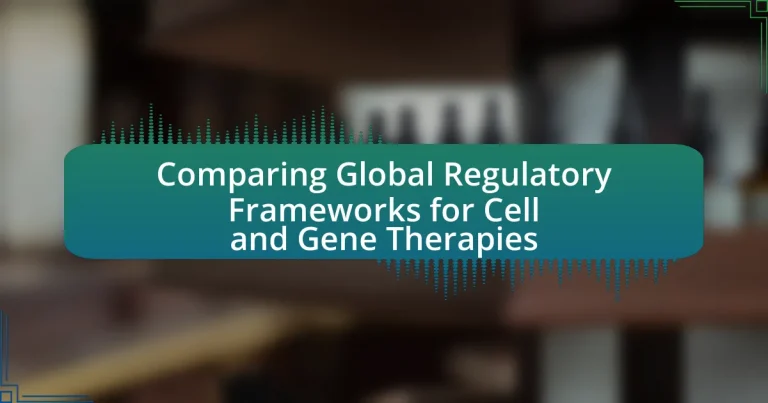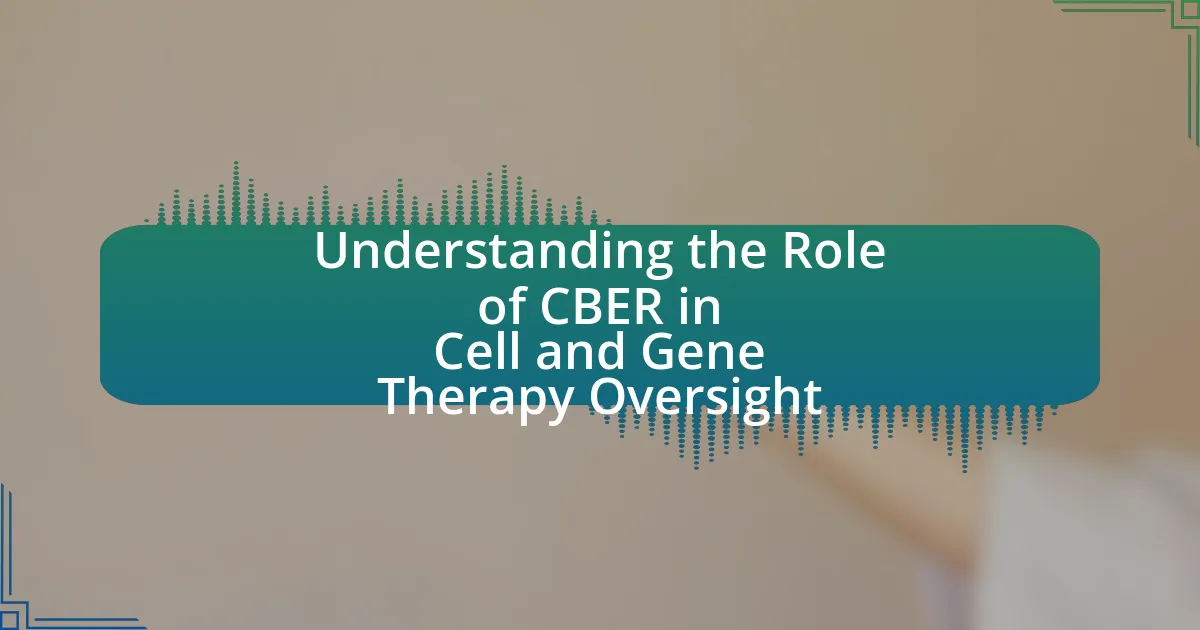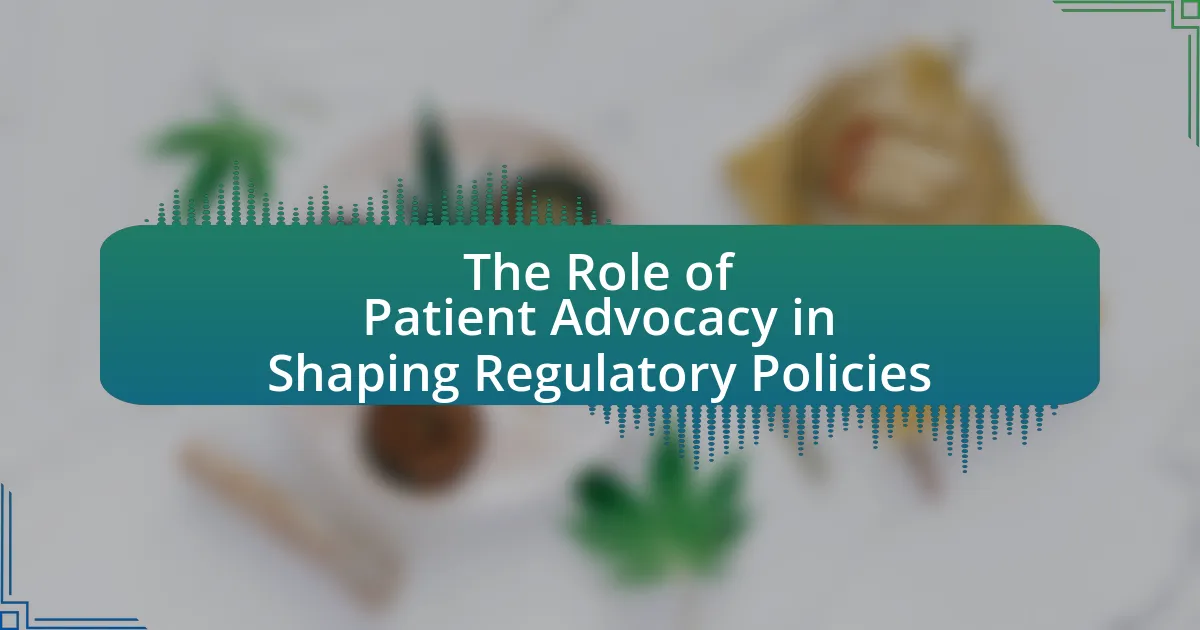The article focuses on the global regulatory frameworks for cell and gene therapies, detailing the guidelines established by key health authorities such as the U.S. Food and Drug Administration (FDA), the European Medicines Agency (EMA), and the World Health Organization (WHO). It examines how different countries approach regulation, highlighting the unique frameworks and approval processes in regions like the United States, European Union, and Japan. The article also discusses the roles of regulatory bodies, the objectives of these frameworks, and the ethical considerations involved. Additionally, it addresses emerging trends in regulatory practices, the implications of regulatory differences for developers, and best practices for compliance and preparation for regulatory submissions.

What are the Global Regulatory Frameworks for Cell and Gene Therapies?
Global regulatory frameworks for cell and gene therapies include guidelines and regulations established by various health authorities worldwide, such as the U.S. Food and Drug Administration (FDA), the European Medicines Agency (EMA), and the World Health Organization (WHO). The FDA regulates these therapies under the Federal Food, Drug, and Cosmetic Act, requiring premarket approval and adherence to Good Manufacturing Practices (GMP). The EMA provides a centralized approval process for gene therapies in the European Union, emphasizing safety, efficacy, and quality. The WHO offers international guidelines to harmonize regulatory approaches, promoting patient safety and ethical standards. These frameworks collectively aim to ensure that cell and gene therapies are safe and effective for public use, reflecting a growing global consensus on the need for robust regulatory oversight in this rapidly evolving field.
How do different countries approach the regulation of cell and gene therapies?
Different countries approach the regulation of cell and gene therapies through varying frameworks that reflect their healthcare priorities and regulatory philosophies. In the United States, the Food and Drug Administration (FDA) oversees these therapies under the Biological Products Control Act, requiring rigorous clinical trials and safety assessments before approval. The European Union employs a centralized regulatory system through the European Medicines Agency (EMA), which mandates a comprehensive evaluation process for marketing authorization, emphasizing both safety and efficacy. In contrast, countries like Japan have implemented the Sakigake Designation System, which accelerates the approval process for innovative therapies, aiming to promote faster access to cutting-edge treatments. Additionally, nations such as China have recently streamlined their regulatory processes to encourage domestic innovation while ensuring safety, reflecting a shift towards more flexible regulations. These diverse regulatory approaches illustrate how different healthcare systems balance innovation, safety, and patient access in the rapidly evolving field of cell and gene therapies.
What are the key regulatory bodies involved in these frameworks?
The key regulatory bodies involved in the frameworks for cell and gene therapies include the U.S. Food and Drug Administration (FDA), the European Medicines Agency (EMA), and the Japan Pharmaceuticals and Medical Devices Agency (PMDA). The FDA oversees the approval and regulation of therapies in the United States, ensuring safety and efficacy through rigorous clinical trials. The EMA is responsible for the evaluation and supervision of medicinal products in the European Union, providing a centralized process for marketing authorization. The PMDA regulates pharmaceuticals and medical devices in Japan, focusing on safety and effectiveness in the Japanese market. These agencies play crucial roles in establishing guidelines and standards that govern the development and commercialization of cell and gene therapies globally.
How do these bodies influence the approval process for therapies?
Regulatory bodies influence the approval process for therapies by establishing guidelines and standards that must be met for a therapy to be considered safe and effective. These organizations, such as the U.S. Food and Drug Administration (FDA) and the European Medicines Agency (EMA), assess clinical trial data, manufacturing processes, and post-market surveillance to ensure compliance with safety and efficacy requirements. For instance, the FDA requires a rigorous review of clinical trial results, which must demonstrate that a therapy provides a therapeutic benefit that outweighs its risks before it can receive approval. This structured evaluation process is critical in determining whether new therapies can be marketed and used in clinical practice, thereby directly impacting patient access to innovative treatments.
What are the main objectives of these regulatory frameworks?
The main objectives of regulatory frameworks for cell and gene therapies are to ensure patient safety, promote efficacy, and facilitate access to innovative treatments. These frameworks establish guidelines for the development, testing, and approval of therapies, thereby minimizing risks associated with novel medical interventions. For instance, the U.S. Food and Drug Administration (FDA) and the European Medicines Agency (EMA) have specific protocols that require rigorous clinical trials to demonstrate safety and effectiveness before therapies can be marketed. This structured approach helps protect patients while encouraging advancements in medical science.
How do these objectives ensure patient safety and efficacy?
The objectives of regulatory frameworks for cell and gene therapies ensure patient safety and efficacy by establishing rigorous standards for clinical trials, manufacturing processes, and post-market surveillance. These frameworks require comprehensive preclinical and clinical data demonstrating that therapies are safe and effective before they can be approved for use. For instance, the U.S. Food and Drug Administration mandates that therapies undergo multiple phases of clinical trials, which include safety assessments and efficacy evaluations, to identify any potential risks and confirm therapeutic benefits. Additionally, ongoing monitoring after approval helps to identify long-term effects and ensures that any adverse events are promptly addressed, thereby reinforcing patient safety and therapeutic effectiveness.
What role do ethical considerations play in these regulations?
Ethical considerations play a crucial role in the regulations governing cell and gene therapies by ensuring that patient safety, informed consent, and equitable access are prioritized. These regulations are designed to address potential risks associated with innovative therapies, such as long-term effects and genetic modifications, which raise significant ethical questions. For instance, the Declaration of Helsinki emphasizes the necessity of informed consent, mandating that participants in clinical trials fully understand the implications of their involvement. Furthermore, ethical frameworks guide regulatory bodies in balancing innovation with public health concerns, as seen in the European Medicines Agency’s guidelines that incorporate ethical assessments in the evaluation process. This integration of ethical considerations helps to foster public trust and acceptance of new therapies while safeguarding human rights and dignity.

What are the Key Differences in Regulatory Approaches Across Regions?
Key differences in regulatory approaches across regions for cell and gene therapies include variations in approval processes, safety and efficacy requirements, and post-market surveillance. For instance, the United States, through the FDA, emphasizes a risk-based approach, allowing for accelerated approvals under the Breakthrough Therapy designation, while the European Medicines Agency (EMA) requires comprehensive data on long-term effects before granting marketing authorization. Additionally, countries like Japan have introduced unique frameworks, such as the Sakigake designation, to expedite innovative therapies. These differences reflect regional priorities, such as balancing patient access with safety concerns, and are influenced by local healthcare systems and regulatory philosophies.
How do the United States and European Union regulations differ?
The United States and European Union regulations differ primarily in their approach to the approval and oversight of cell and gene therapies. In the United States, the Food and Drug Administration (FDA) employs a more streamlined and flexible regulatory pathway, allowing for faster access to therapies through mechanisms like the Breakthrough Therapy designation. Conversely, the European Union’s European Medicines Agency (EMA) follows a more rigorous and structured process, often requiring extensive clinical data and a longer review period before granting marketing authorization. This difference is evident in the approval timelines; for instance, the FDA can approve therapies in as little as six months, while the EMA typically takes around 12 months or longer. Additionally, the EU places a stronger emphasis on post-market surveillance and long-term monitoring of therapies, reflecting its precautionary principle in health regulation.
What specific guidelines govern cell and gene therapies in the US?
The specific guidelines governing cell and gene therapies in the US are primarily established by the Food and Drug Administration (FDA) under the Federal Food, Drug, and Cosmetic Act. These guidelines include the requirement for Investigational New Drug (IND) applications for clinical trials, adherence to Good Manufacturing Practices (GMP), and compliance with the Biological Products Control Act for products classified as biologics. The FDA also issues guidance documents that outline the regulatory expectations for the development and approval of cell and gene therapies, such as the “Guidance for Industry: Gene Therapy Clinical Trials” and “Guidance for Industry: Human Gene Therapy for Rare Diseases.” These documents provide detailed information on safety, efficacy, and manufacturing standards necessary for regulatory approval.
What are the unique aspects of the EU’s regulatory framework?
The unique aspects of the EU’s regulatory framework include its centralized approval process, stringent safety and efficacy requirements, and the emphasis on patient protection and ethical considerations. The European Medicines Agency (EMA) oversees the centralized procedure, allowing for a single marketing authorization valid across all EU member states, which streamlines access to therapies. Additionally, the EU mandates comprehensive preclinical and clinical trial data to demonstrate safety and efficacy, reflecting its commitment to high standards in healthcare. Furthermore, the EU’s regulations incorporate specific provisions for advanced therapies, such as cell and gene therapies, ensuring that ethical guidelines are adhered to, particularly concerning genetic modifications and patient consent. These elements collectively distinguish the EU’s approach from other global regulatory frameworks, emphasizing a balance between innovation and public health safety.
What are the implications of these differences for developers?
The differences in global regulatory frameworks for cell and gene therapies significantly impact developers by influencing their research, development timelines, and market access strategies. For instance, developers must navigate varying approval processes, which can lead to delays in bringing therapies to market; the U.S. FDA’s expedited pathways differ from the more stringent requirements in the EU, affecting how quickly developers can initiate clinical trials. Additionally, these regulatory discrepancies can result in increased costs for compliance and adaptation of therapies to meet diverse regional standards, ultimately shaping the strategic decisions developers make regarding investment and resource allocation.
How do regulatory timelines vary between regions?
Regulatory timelines for cell and gene therapies vary significantly between regions due to differences in regulatory frameworks and approval processes. For instance, the U.S. Food and Drug Administration (FDA) typically has a review timeline of about 10 months for new biologics, while the European Medicines Agency (EMA) can take up to 12 months for similar approvals. In contrast, countries like Japan have expedited pathways that can shorten the timeline to as little as 6 months under specific conditions. These variations are influenced by factors such as the complexity of the therapy, the regulatory body’s resources, and the urgency of the medical need, which can lead to faster approvals in some regions compared to others.
What challenges do companies face when navigating multiple regulatory environments?
Companies face significant challenges when navigating multiple regulatory environments, including compliance complexity, varying standards, and increased costs. Compliance complexity arises from the need to understand and adhere to different regulations across jurisdictions, which can lead to confusion and potential legal issues. Varying standards mean that a product approved in one region may not meet the requirements in another, delaying market entry and increasing the risk of non-compliance. Increased costs stem from the need for additional resources, such as legal expertise and regulatory consultants, to manage the diverse regulatory landscapes effectively. These challenges are particularly pronounced in the field of cell and gene therapies, where regulations can differ widely between regions, impacting development timelines and market strategies.

What are the Emerging Trends in Global Regulatory Frameworks?
Emerging trends in global regulatory frameworks for cell and gene therapies include increased harmonization of regulations, a focus on adaptive pathways for approval, and enhanced collaboration between regulatory agencies. Regulatory bodies, such as the FDA and EMA, are working towards aligning their guidelines to facilitate faster access to innovative therapies. For instance, the FDA’s Breakthrough Therapy designation and the EMA’s PRIME scheme exemplify adaptive pathways that allow for earlier patient access while ensuring safety and efficacy. Additionally, initiatives like the International Council for Harmonisation (ICH) aim to standardize regulatory requirements across regions, promoting consistency and efficiency in the approval process. These trends reflect a shift towards more flexible and responsive regulatory environments that can keep pace with rapid advancements in biotechnology.
How is the regulatory landscape evolving for cell and gene therapies?
The regulatory landscape for cell and gene therapies is evolving towards more streamlined and adaptive frameworks to facilitate innovation while ensuring patient safety. Regulatory agencies, such as the FDA and EMA, are increasingly implementing expedited pathways, like the FDA’s Regenerative Medicine Advanced Therapy designation, which allows for faster review processes for promising therapies. Additionally, there is a growing emphasis on harmonizing regulations across jurisdictions to simplify global access; for instance, the International Council for Harmonisation is working on guidelines that address the unique challenges posed by these therapies. This evolution is supported by the increasing number of approved therapies, which reached over 20 gene therapies in the U.S. by 2023, reflecting a trend towards more robust regulatory frameworks that balance innovation with safety and efficacy.
What innovations are being introduced in regulatory processes?
Innovations in regulatory processes for cell and gene therapies include the implementation of adaptive licensing, real-world evidence integration, and streamlined approval pathways. Adaptive licensing allows for phased market access based on ongoing clinical data, enabling quicker patient access while ensuring safety and efficacy. Real-world evidence integration utilizes data from actual patient experiences to inform regulatory decisions, enhancing the understanding of treatment impacts post-approval. Streamlined approval pathways, such as the FDA’s Breakthrough Therapy designation, expedite the review process for therapies that address unmet medical needs. These innovations are supported by regulatory agencies’ efforts to balance patient access with rigorous safety standards, as seen in the European Medicines Agency’s initiatives to facilitate timely access to advanced therapies.
How are international collaborations shaping these frameworks?
International collaborations are shaping regulatory frameworks for cell and gene therapies by fostering harmonization of standards and practices across countries. These collaborations, such as the International Council for Harmonisation of Technical Requirements for Pharmaceuticals for Human Use (ICH), facilitate the sharing of scientific knowledge and regulatory experiences, which leads to more consistent and efficient approval processes. For instance, the ICH has established guidelines that many countries adopt, thereby reducing discrepancies in regulatory requirements and expediting access to innovative therapies. Additionally, collaborative initiatives like the Global Coalition for Regulatory Science Research promote joint research efforts, enhancing the understanding of safety and efficacy in diverse populations, which further informs regulatory decisions.
What best practices can be adopted for compliance with global regulations?
To ensure compliance with global regulations in cell and gene therapies, organizations should adopt a comprehensive regulatory strategy that includes thorough understanding of local regulations, continuous training for staff, and robust documentation practices. Understanding local regulations is crucial, as different countries have varying requirements for clinical trials, product approvals, and post-market surveillance. Continuous training ensures that all team members are updated on regulatory changes and best practices, which is essential for maintaining compliance. Robust documentation practices facilitate transparency and accountability, making it easier to demonstrate compliance during audits or inspections. These practices are supported by the International Council for Harmonisation (ICH) guidelines, which emphasize the importance of harmonized regulatory standards across regions.
How can companies prepare for regulatory submissions effectively?
Companies can prepare for regulatory submissions effectively by establishing a comprehensive regulatory strategy that aligns with the specific requirements of each jurisdiction. This involves conducting thorough research on the regulatory landscape, including understanding the guidelines set forth by agencies such as the FDA, EMA, and other relevant authorities.
Additionally, companies should engage in early and continuous dialogue with regulatory bodies to clarify expectations and address potential concerns. Implementing robust data management practices ensures that all necessary documentation, including clinical trial data and manufacturing processes, is accurate and readily available.
Furthermore, utilizing regulatory consultants or experts can provide valuable insights and enhance the submission process. According to a study published in the Journal of Regulatory Science, companies that adopt a proactive approach to regulatory engagement and documentation preparation experience a 30% reduction in submission timelines.
What resources are available to assist in understanding these frameworks?
Resources available to assist in understanding global regulatory frameworks for cell and gene therapies include official regulatory agency publications, academic journals, and industry guidelines. Regulatory agencies such as the U.S. Food and Drug Administration (FDA) and the European Medicines Agency (EMA) provide comprehensive guidelines and frameworks on their websites, detailing the approval processes and requirements for cell and gene therapies. Academic journals like “Nature Biotechnology” and “Molecular Therapy” publish peer-reviewed articles that analyze and compare regulatory approaches across different regions. Additionally, organizations such as the International Society for Cell and Gene Therapy (ISCT) offer resources, webinars, and workshops aimed at educating stakeholders about regulatory practices and developments in the field. These resources collectively enhance understanding of the complexities involved in the regulation of cell and gene therapies globally.




